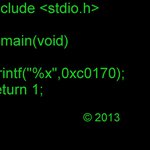The official Mbed 2 C/C++ SDK provides the software platform and libraries to build your applications.
Dependents: hello SerialTestv11 SerialTestv12 Sierpinski ... more
mbed 2
This is the mbed 2 library. If you'd like to learn about Mbed OS please see the mbed-os docs.
TARGET_SAMD21G18A/TOOLCHAIN_GCC_ARM/dac_feature.h
- Committer:
- AnnaBridge
- Date:
- 2019-02-20
- Revision:
- 172:65be27845400
- Parent:
- 171:3a7713b1edbc
File content as of revision 172:65be27845400:
/**
* \file
*
* \brief SAM Peripheral Digital-to-Analog Converter Driver
*
* Copyright (C) 2012-2015 Atmel Corporation. All rights reserved.
*
* \asf_license_start
*
* \page License
*
* Redistribution and use in source and binary forms, with or without
* modification, are permitted provided that the following conditions are met:
*
* 1. Redistributions of source code must retain the above copyright notice,
* this list of conditions and the following disclaimer.
*
* 2. Redistributions in binary form must reproduce the above copyright notice,
* this list of conditions and the following disclaimer in the documentation
* and/or other materials provided with the distribution.
*
* 3. The name of Atmel may not be used to endorse or promote products derived
* from this software without specific prior written permission.
*
* 4. This software may only be redistributed and used in connection with an
* Atmel microcontroller product.
*
* THIS SOFTWARE IS PROVIDED BY ATMEL "AS IS" AND ANY EXPRESS OR IMPLIED
* WARRANTIES, INCLUDING, BUT NOT LIMITED TO, THE IMPLIED WARRANTIES OF
* MERCHANTABILITY, FITNESS FOR A PARTICULAR PURPOSE AND NON-INFRINGEMENT ARE
* EXPRESSLY AND SPECIFICALLY DISCLAIMED. IN NO EVENT SHALL ATMEL BE LIABLE FOR
* ANY DIRECT, INDIRECT, INCIDENTAL, SPECIAL, EXEMPLARY, OR CONSEQUENTIAL
* DAMAGES (INCLUDING, BUT NOT LIMITED TO, PROCUREMENT OF SUBSTITUTE GOODS
* OR SERVICES; LOSS OF USE, DATA, OR PROFITS; OR BUSINESS INTERRUPTION)
* HOWEVER CAUSED AND ON ANY THEORY OF LIABILITY, WHETHER IN CONTRACT,
* STRICT LIABILITY, OR TORT (INCLUDING NEGLIGENCE OR OTHERWISE) ARISING IN
* ANY WAY OUT OF THE USE OF THIS SOFTWARE, EVEN IF ADVISED OF THE
* POSSIBILITY OF SUCH DAMAGE.
*
* \asf_license_stop
*
*/
/*
* Support and FAQ: visit <a href="http://www.atmel.com/design-support/">Atmel Support</a>
*/
#ifndef DAC_FEATURE_H_INCLUDED
#define DAC_FEATURE_H_INCLUDED
/**
* \defgroup asfdoc_sam0_dac_group SAM Digital-to-Analog Driver (DAC)
*
* This driver for Atmel® | SMART ARM®-based microcontrollers provides an interface for the conversion of
* digital values to analog voltage. The following driver API modes are covered
* by this manual:
*
* - Polled APIs
* \if DAC_CALLBACK_MODE
* - Callback APIs
* \endif
*
* The following peripherals are used by this module:
* - DAC (Digital-to-Analog Converter)
*
* The following devices can use this module:
* - Atmel | SMART SAM D20/D21
* - Atmel | SMART SAM D10/D11
* - Atmel | SMART SAM DA0/DA1
* - Atmel | SMART SAM C21
*
* The outline of this documentation is as follows:
* - \ref asfdoc_sam0_dac_prerequisites
* - \ref asfdoc_sam0_dac_module_overview
* - \ref asfdoc_sam0_dac_special_considerations
* - \ref asfdoc_sam0_dac_extra_info
* - \ref asfdoc_sam0_dac_examples
* - \ref asfdoc_sam0_dac_api_overview
*
*
* \section asfdoc_sam0_dac_prerequisites Prerequisites
*
* There are no prerequisites for this module.
*
*
* \section asfdoc_sam0_dac_module_overview Module Overview
*
* The Digital-to-Analog converter converts a digital value to analog voltage.
* The SAM DAC module has one channel with 10-bit resolution,
* and is capable of converting up to 350k samples per second (ksps).
*
* A common use of DAC is to generate audio signals by connecting the DAC
* output to a speaker, or to generate a reference voltage; either for an
* external circuit or an internal peripheral such as the Analog Comparator.
*
* After being set up, the DAC will convert new digital values written to the
* conversion data register (DATA) to an analog value either on the VOUT pin of
* the device, or internally for use as an input to the AC, ADC, and other analog
* modules.
*
* Writing the DATA register will start a new conversion. It is also possible
* to trigger the conversion from the event system.
*
* A simplified block diagram of the DAC can be seen in
* \ref asfdoc_sam0_dac_module_block_diagram "the figure below".
*
* \anchor asfdoc_sam0_dac_module_block_diagram
* \image html dac_block_diagram.svg "DAC Block Diagram"
*
* \subsection asfdoc_sam0_dac_conversion_range Conversion Range
* The conversion range is between GND and the selected voltage reference.
* Available voltage references are:
* \li AVCC voltage reference
* \li Internal 1V reference (INT1V)
* \li External voltage reference (AREF)
*
* \note Internal references will be enabled by the driver, but not disabled.
* Any reference not used by the application should be disabled by the application.
*
* The output voltage from a DAC channel is given as:
* \f[
* V_{OUT} = \frac{DATA}{0x3FF} \times VREF
* \f]
*
* \subsection asfdoc_sam0_dac_conversion Conversion
* The digital value written to the conversion data register (DATA) will be
* converted to an analog value.
* Writing the DATA register will start a new conversion.
* It is also possible to write the conversion data to the DATABUF register,
* the writing of the DATA register can then be triggered from the event
* system, which will load the value from DATABUF to DATA.
*
* \subsection asfdoc_sam0_dac_analog_output Analog Output
* The analog output value can be output to either the VOUT pin or internally,
* but not both at the same time.
*
* \subsubsection asfdoc_sam0_dac_analog_output_external External Output
* The output buffer must be enabled in order to drive the DAC output to the
* VOUT pin. Due to the output buffer, the DAC has high drive strength, and is
* capable of driving both resistive and capacitive loads, as well as loads
* which combine both.
*
* \subsubsection asfdoc_sam0_dac_analog_output_internal Internal Output
* The analog value can be internally available for use as input to the
* AC or ADC modules.
*
* \subsection asfdoc_sam0_dac_events Events
* Events generation and event actions are configurable in the DAC.
* The DAC has one event line input and one event output: <i>Start Conversion</i>
* and <i>Data Buffer Empty</i>.
*
* If the Start Conversion input event is enabled in the module configuration,
* an incoming event will load data from the data buffer to the data register
* and start a new conversion. This method synchronizes conversions with
* external events (such as those from a timer module) and ensures regular and
* fixed conversion intervals.
*
* If the Data Buffer Empty output event is enabled in the module configuration,
* events will be generated when the DAC data buffer register becomes empty and
* new data can be loaded to the buffer.
*
* \note The connection of events between modules requires the use of the
* \ref asfdoc_sam0_events_group "SAM Event System Driver (EVENTS)"
* to route output event of one module to the the input event of another.
* For more information on event routing, refer to the event driver
* documentation.
*
* \subsection asfdoc_sam0_dac_data_adjust Left and Right Adjusted Values
* The 10-bit input value to the DAC is contained in a 16-bit register. This
* can be configured to be either left or right adjusted. In
* \ref asfdoc_sam0_dac_module_adj_modes "the figure below" both options are
* shown, and the position of the most (MSB) and the least (LSB) significant bits
* are indicated. The unused bits should always be written to zero.
*
* \anchor asfdoc_sam0_dac_module_adj_modes
* \dot
* digraph {
* subgraph cluster_right {
* msbl [label="MSB", shape=none, group="msbl"];
* lsbl [label="LSB", shape=none];
* node [shape=none];
* color="white";
* reg_left [label=<
* <table cellspacing="0" cellpadding="2" width="100%">
* <tr>
* <td port="msb">15</td>
* <td>14</td>
* <td>13</td>
* <td>12</td>
* <td>11</td>
* <td>10</td>
* <td>9</td>
* <td>8</td>
* <td>7</td>
* <td port="lsb">6</td>
* <td>5</td>
* <td>4</td>
* <td>3</td>
* <td>2</td>
* <td>1</td>
* <td>0</td>
* </tr>
* <tr>
* <td COLSPAN="10"> DATA[9:0] </td>
* <td BGCOLOR="lightgray"> </td>
* <td BGCOLOR="lightgray"> </td>
* <td BGCOLOR="lightgray"> </td>
* <td BGCOLOR="lightgray"> </td>
* <td BGCOLOR="lightgray"> </td>
* <td BGCOLOR="lightgray"> </td>
* </tr>
* </table>
* >];
* msbl -> reg_left:msb:n;
* lsbl -> reg_left:lsb;
* label ="Left adjusted.\n";
* }
* subgraph cluster_left {
* rankdir=TB;
* msb [label="MSB", shape=none];
* lsb [label="LSB", shape=none];
* color="white";
* node [shape=none];
* reg_right [label=<
* <table cellspacing="0" cellpadding="2">
* <tr>
* <td>15</td>
* <td>14</td>
* <td>13</td>
* <td>12</td>
* <td>11</td>
* <td>10</td>
* <td port="msb">9</td>
* <td>8</td>
* <td>7</td>
* <td>6</td>
* <td>5</td>
* <td>4</td>
* <td>3</td>
* <td>2</td>
* <td>1</td>
* <td port="lsb">0</td>
* </tr>
* <tr>
* <td BGCOLOR="lightgray"></td>
* <td BGCOLOR="lightgray"></td>
* <td BGCOLOR="lightgray"></td>
* <td BGCOLOR="lightgray"></td>
* <td BGCOLOR="lightgray"></td>
* <td BGCOLOR="lightgray"></td>
* <td COLSPAN="10"> DATA[9:0] </td>
* </tr>
* </table>
* >];
* msb -> reg_right:msb;
* lsb -> reg_right:lsb:n;
* label = "Right adjusted.\n";
* graph [shape=none];
* }
* }
* \enddot
*
* \subsection asfdoc_sam0_dac_clk_sources Clock Sources
* The clock for the DAC interface (CLK_DAC) is generated by the Power Manager.
* This clock is turned on by default, and can be enabled and disabled in the
* Power Manager.
*
* Additionally, an asynchronous clock source (GCLK_DAC) is required.
* These clocks are normally disabled by default. The selected clock source
* must be enabled in the Power Manager before it can be used by the DAC.
* The DAC core operates asynchronously from the user interface and
* peripheral bus. As a consequence, the DAC needs two clock cycles of both
* CLK_DAC and GCLK_DAC to synchronize the values written to some of the
* control and data registers.
* The oscillator source for the GCLK_DAC clock is selected in the System
* Control Interface (SCIF).
*
* \section asfdoc_sam0_dac_special_considerations Special Considerations
*
* \subsection asfdoc_sam0_dac_special_considerations_output_buffer Output Driver
* The DAC can only do conversions in Active or Idle modes. However, if the
* output buffer is enabled it will draw current even if the system is in
* sleep mode. Therefore, always make sure that the output buffer is not
* enabled when it is not needed, to ensure minimum power consumption.
*
* \subsection asfdoc_sam0_dac_special_considerations_conversion_time Conversion Time
* DAC conversion time is approximately 2.85µs. The user must ensure that new
* data is not written to the DAC before the last conversion is complete.
* Conversions should be triggered by a periodic event from a Timer/Counter or
* another peripheral.
*
*
* \section asfdoc_sam0_dac_extra_info Extra Information
*
* For extra information, see \ref asfdoc_sam0_dac_extra. This includes:
* - \ref asfdoc_sam0_dac_extra_acronyms
* - \ref asfdoc_sam0_dac_extra_dependencies
* - \ref asfdoc_sam0_dac_extra_errata
* - \ref asfdoc_sam0_dac_extra_history
*
*
* \section asfdoc_sam0_dac_examples Examples
*
* For a list of examples related to this driver, see
* \ref asfdoc_sam0_dac_exqsg.
*
*
* \section asfdoc_sam0_dac_api_overview API Overview
* @{
*/
#ifdef __cplusplus
extern "C" {
#endif
#include <compiler.h>
#include <clock.h>
#include <gclk.h>
/**
* \name DAC Status Flags
*
* DAC status flags, returned by \ref dac_get_status() and cleared by
* \ref dac_clear_status().
* @{
*/
/** Data Buffer Empty Channel 0 - Set when data is transferred from DATABUF
* to DATA by a start conversion event and DATABUF is ready for new data.
*/
#define DAC_STATUS_CHANNEL_0_EMPTY (1UL << 0)
/** Under-run Channel 0 - Set when a start conversion event occurs when
* DATABUF is empty.
*/
#define DAC_STATUS_CHANNEL_0_UNDERRUN (1UL << 1)
/** @} */
/**
* \brief DAC reference voltage enum.
*
* Enum for the possible reference voltages for the DAC.
*/
enum dac_reference {
/** 1V from the internal band-gap reference.*/
DAC_REFERENCE_INT1V = DAC_CTRLB_REFSEL(0),
/** Analog V<SUB>CC</SUB> as reference. */
DAC_REFERENCE_AVCC = DAC_CTRLB_REFSEL(1),
/** External reference on AREF. */
DAC_REFERENCE_AREF = DAC_CTRLB_REFSEL(2),
};
/**
* \brief DAC output selection enum.
*
* Enum for the DAC output selection.
*/
enum dac_output {
/** DAC output to VOUT pin */
DAC_OUTPUT_EXTERNAL = DAC_CTRLB_EOEN,
/** DAC output as internal reference */
DAC_OUTPUT_INTERNAL = DAC_CTRLB_IOEN,
/** No output */
DAC_OUTPUT_NONE = 0,
};
/**
* \brief DAC channel selection enum.
*
* Enum for the DAC channel selection.
*/
enum dac_channel {
/** DAC output channel 0. */
DAC_CHANNEL_0,
};
/**
* \brief DAC software device instance structure.
*
* DAC software instance structure, used to retain software state information
* of an associated hardware module instance.
*
* \note The fields of this structure should not be altered by the user
* application; they are reserved for module-internal use only.
*/
struct dac_module {
#if !defined(__DOXYGEN__)
/** DAC hardware module. */
Dac *hw;
/** DAC output selection. */
enum dac_output output;
/** Reference selection. */
enum dac_reference reference;
/** DAC event selection. */
bool start_on_event;
# if DAC_CALLBACK_MODE == true
/** Pointer to buffer used for ADC results. */
volatile uint16_t *job_buffer;
/** Remaining number of conversions in current job. */
volatile uint16_t remaining_conversions;
/** Transferred number of conversions in current job. */
volatile uint16_t transferred_conversions;
/** DAC callback enable. */
bool callback_enable[DAC_CALLBACK_N];
/** DAC registered callback functions. */
dac_callback_t callback[DAC_CALLBACK_N];
/** Holds the status of the ongoing or last conversion job. */
volatile enum status_code job_status;
# endif
#endif
};
/**
* \brief DAC configuration structure.
*
* Configuration structure for a DAC instance. This structure should be
* initialized by the \ref dac_get_config_defaults()
* function before being modified by the user application.
*/
struct dac_config {
/** Reference voltage. */
enum dac_reference reference;
/** Select DAC output. */
enum dac_output output;
/** Left adjusted data. */
bool left_adjust;
/** GCLK generator used to clock the peripheral. */
enum gclk_generator clock_source;
#ifdef FEATURE_DAC_DATABUF_WRITE_PROTECTION
/** Bypass DATABUF write protection. */
bool databuf_protection_bypass;
#endif
/** Voltage pump disable. */
bool voltage_pump_disable;
/**
* The DAC behaves as in normal mode when the chip enters STANDBY sleep
* mode.
*/
bool run_in_standby;
#if (SAMC21)
/** Dither mode enable data. */
bool dither_mode;
#endif
};
/**
* \brief DAC event enable/disable structure.
*
* Event flags for the DAC module. This is used to enable and
* disable events via \ref dac_enable_events() and \ref dac_disable_events().
*/
struct dac_events {
/** Start a new DAC conversion. */
bool on_event_start_conversion;
/** Enable event generation on data buffer empty. */
bool generate_event_on_buffer_empty;
#if (SAMC21)
/** Enable the falling edge of the input event for DAC1. */
bool generate_event_on_chan_falling_edge;
#endif
};
/**
* \brief DAC channel configuration structure
*
* Configuration for a DAC channel. This structure should be initialized by the
* \ref dac_chan_get_config_defaults() function before being modified by the
* user application.
*/
struct dac_chan_config {
#if !defined(__DOXYGEN__)
/** Dummy value to ensure the struct has at least one member. */
uint8_t _dummy;
#endif
};
/**
* \name Configuration and Initialization (Channel)
* @{
*/
void dac_chan_enable_output_buffer(
struct dac_module *const dev_inst,
const enum dac_channel channel);
void dac_chan_disable_output_buffer(
struct dac_module *const dev_inst,
const enum dac_channel channel);
/** @} */
/** @} */
/**
* \page asfdoc_sam0_dac_extra Extra Information for DAC Driver
*
* \section asfdoc_sam0_dac_extra_acronyms Acronyms
* The table below presents the acronyms used in this module:
*
* <table>
* <tr>
* <th>Acronym</th>
* <th>Description</th>
* </tr>
* <tr>
* <td>ADC</td>
* <td>Analog-to-Digital Converter</td>
* </tr>
* <tr>
* <td>AC</td>
* <td>Analog Comparator</td>
* </tr>
* <tr>
* <td>DAC</td>
* <td>Digital-to-Analog Converter</td>
* </tr>
* <tr>
* <td>LSB</td>
* <td>Least Significant Bit</td>
* </tr>
* <tr>
* <td>MSB</td>
* <td>Most Significant Bit</td>
* </tr>
* <tr>
* <td>DMA</td>
* <td>Direct Memory Access</td>
* </tr>
* </table>
*
*
* \section asfdoc_sam0_dac_extra_dependencies Dependencies
* This driver has the following dependencies:
*
* - \ref asfdoc_sam0_system_pinmux_group "System Pin Multiplexer Driver"
*
*
* \section asfdoc_sam0_dac_extra_errata Errata
* There are no errata related to this driver.
*
*
* \section asfdoc_sam0_dac_extra_history Module History
* An overview of the module history is presented in the table below, with
* details on the enhancements and fixes made to the module since its first
* release. The current version of this corresponds to the newest version in
* the table.
*
* <table>
* <tr>
* <th>Changelog</th>
* </tr>
* <tr>
* <td>Add configuration for using 14-bit hardware dithering (SAMC21 support)</td>
* </tr>
* <tr>
* <td>Added new configuration parameters \c databuf_protection_bypass,
* \c voltage_pump_disable. Added new callback functions
* \c dac_chan_write_buffer_wait,
* \c dac_chan_write_buffer_job, \c dac_chan_write_job,
* \c dac_get_job_status, \c dac_abort_job and new callback type
* \c DAC_CALLBACK_TRANSFER_COMPLETE for DAC conversion job</td>
* </tr>
* <tr>
* <td>Initial Release</td>
* </tr>
* </table>
*/
/**
* \page asfdoc_sam0_dac_exqsg Examples for DAC Driver
*
* This is a list of the available Quick Start guides (QSGs) and example
* applications for \ref asfdoc_sam0_dac_group. QSGs are simple examples with
* step-by-step instructions to configure and use this driver in a selection of
* use cases. Note that a QSG can be compiled as a standalone application or be
* added to the user application.
*
* - \subpage asfdoc_sam0_dac_basic_use_case
* \if DAC_CALLBACK_MODE
* - \subpage asfdoc_sam0_dac_basic_use_case_callback
* \endif
* \if DAC_DMA_USE_MODE_SELECTION
* - \subpage asfdoc_sam0_adc_dma_use_case_dac_in_dma
* \endif
*
* \if DAC_DMA_USE_MODE_SELECTION
* \page asfdoc_sam0_adc_dma_use_case_dac_in_dma Quick Start Guide for Using DMA with ADC/DAC
* For this examples, see
* \ref asfdoc_sam0_adc_dma_use_case
* \endif
*
* \page asfdoc_sam0_dac_document_revision_history Document Revision History
*
* <table>
* <tr>
* <th>Doc. Rev.</td>
* <th>Date</td>
* <th>Comments</td>
* </tr>
* <tr>
* <td>42110E</td>
* <td>06/2015</td>
* <td>Add SAMC21 and SAMDAx support</td>
* </tr>
* <tr>
* <td>42110D</td>
* <td>12/2014</td>
* <td>Add SAMD10/D11 support</td>
* </tr>
* <tr>
* <td>42110C</td>
* <td>01/2014</td>
* <td>Add SAMD21 support</td>
* </tr>
* <tr>
* <td>42110B</td>
* <td>06/2013</td>
* <td>Added additional documentation on the event system. Corrected
* documentation typos.</td>
* </tr>
* <tr>
* <td>42110A</td>
* <td>06/2013</td>
* <td>Initial document release</td>
* </tr>
* </table>
*/
#ifdef __cplusplus
}
#endif
#endif /* DAC_FEATURE_H_INCLUDED */
 mbed official
mbed official




